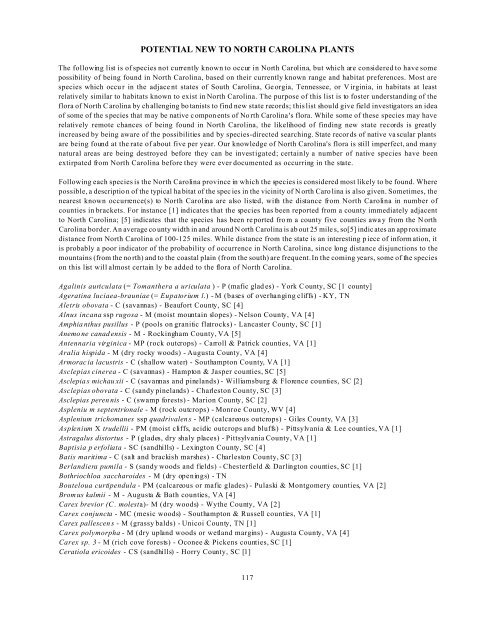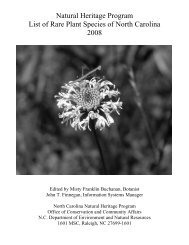Natural Heritage Program List of Rare Plant Species - Rawlings ...
Natural Heritage Program List of Rare Plant Species - Rawlings ...
Natural Heritage Program List of Rare Plant Species - Rawlings ...
Create successful ePaper yourself
Turn your PDF publications into a flip-book with our unique Google optimized e-Paper software.
POTENTIAL NEW TO NORTH CAROLINA PLANTS<br />
The following list is <strong>of</strong> species not currently known to occur in North Carolina, but which are considered to have some<br />
possibility <strong>of</strong> being found in North Carolina, based on their currently known range and habitat preferences. Most are<br />
species which occur in the adjacent states <strong>of</strong> South Carolina, Georgia, Tennessee, or V irginia, in habitats at least<br />
relatively similar to habitats known to exist in North Carolina. The purpose <strong>of</strong> this list is to foster understanding <strong>of</strong> the<br />
flora <strong>of</strong> North C arolina by challenging botanists to find new state records; this list should give field investigators an idea<br />
<strong>of</strong> some <strong>of</strong> the species that may be native components <strong>of</strong> North Carolina's flora. While some <strong>of</strong> these species may have<br />
relatively remote chances <strong>of</strong> being found in North Carolina, the likelihood <strong>of</strong> finding new state records is greatly<br />
increased by being aware <strong>of</strong> the possibilities and by species-directed searching. State records <strong>of</strong> native vascular plants<br />
are being found at the rate <strong>of</strong> about five per year. Our knowledge <strong>of</strong> North Carolina's flora is still imperfect, and many<br />
natural areas are being destroyed before they can be investigated; certainly a number <strong>of</strong> native species have been<br />
extirpated from North Carolina before they were ever documented as occurring in the state.<br />
Following each species is the North Carolina province in which the species is considered most likely to be found. Where<br />
possible, a description <strong>of</strong> the typical habitat <strong>of</strong> the spec ies in the vicinity <strong>of</strong> North Carolina is also given. Sometimes, the<br />
nearest known occurrence(s) to North Carolina are also listed, with the distance from North Carolina in number <strong>of</strong><br />
counties in brackets. For instance [1] indicates that the species has been reported from a county immediately adjacent<br />
to North Carolina; [5] indicates that the species has been reported from a county five counties away from the North<br />
Carolina border. An average co unty width in and around N orth Carolina is ab out 25 miles, so[5] indicates an approximate<br />
distance from North Carolina <strong>of</strong> 100-125 miles. While distance from the state is an interesting p iece <strong>of</strong> information, it<br />
is probably a poor indicator <strong>of</strong> the probability <strong>of</strong> occurrence in North Carolina, since long distance disjunctions to the<br />
mountains (from the north) and to the coastal plain (from the south) are frequent. In the coming years, some <strong>of</strong> the species<br />
on this list will almost certain ly be added to the flora <strong>of</strong> North Carolina.<br />
Agalinis auriculata (= Tomanthera a uriculata ) - P (mafic glad es) - York C ounty, SC [1 county]<br />
Ageratina luciaea-brauniae (= Eupatorium l.) - M (bases <strong>of</strong> overhanging cliffs) - KY, TN<br />
Aletris obovata - C (savannas) - Beaufort County, SC [4]<br />
Alnus incana ssp rugosa - M (moist mountain slopes) - Nelson County, VA [4]<br />
Amphianthus pusillus - P (pools on granitic flatrocks) - Lancaster County, SC [1]<br />
Anemone canadensis - M - Rockingham County, VA [5]<br />
Antennaria virginica - MP (rock outcrops) - Carroll & Patrick counties, VA [1]<br />
Aralia hispida - M (dry rocky woods) - Augusta County, VA [4]<br />
Armoracia lacustris - C (shallow water) - Southampton County, VA [1]<br />
Asclepias cinerea - C (savannas) - Hampton & Jasper counties, SC [5]<br />
Asclepias michau xii - C (savannas and pinelands) - Williamsburg & Florence counties, SC [2]<br />
Asclepias obovata - C (sandy pinelands) - Charleston County, SC [3]<br />
Asclepias perennis - C (swamp forests) - Marion County, SC [2]<br />
Aspleniu m septentrionale - M (rock outcrops) - Monroe County, WV [4]<br />
Asplenium trichomanes ssp quadrivalens - MP (calcareous outcrops) - Giles County, VA [3]<br />
Asplenium X trudellii - PM (moist cliffs, acidic outcrops and bluffs) - Pittsylvania & Lee counties, VA [1]<br />
Astragalus distortus - P (glades, dry shaly places) - Pittsylvania County, VA [1]<br />
Baptisia p erfoliata - SC (sandhills) - Lexington County, SC [4]<br />
Batis maritima - C (salt and brackish marshes) - Charleston County, SC [3]<br />
Berlandiera pumila - S (sandy woods and fields) - Chesterfield & Darlington counties, SC [1]<br />
Bothriochloa saccharoides - M (dry openings) - TN<br />
Bouteloua curtipendula - PM (calcareous or mafic glades) - Pulaski & Montgomery counties, VA [2]<br />
Bromus kalmii - M - Augusta & Bath counties, VA [4]<br />
Carex brevior (C. molesta)- M (dry woods) - Wythe County, VA [2]<br />
Carex conjuncta - MC (mesic woods) - Southampton & Russell counties, VA [1]<br />
Carex pallescens - M (grassy balds) - Unicoi County, TN [1]<br />
Carex polymorpha - M (dry upland woods or wetland margins) - Augusta County, VA [4]<br />
Carex sp. 3 - M (rich cove forests) - Oconee & Pickens counties, SC [1]<br />
Ceratiola ericoides - CS (sandhills) - Horry County, SC [1]<br />
117




